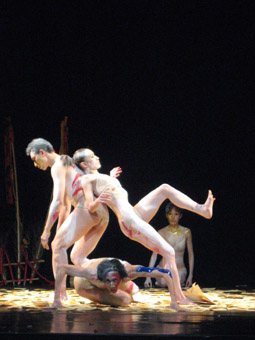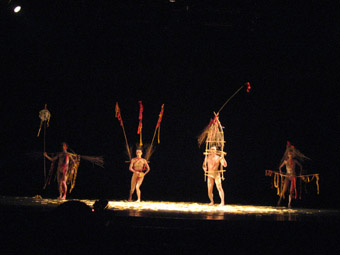dancing to the threshhold
bilqis hijjas: cross over dance company, middle

Middle
photo Phalla San
Middle
A MANDALA OF YELLOW SPIRIT MONEY COVERS THE CENTRE OF THE STAGE LIKE A YELLOW BRICK ROAD TO OTHER WORLDS. THREE ALMOST NAKED FIGURES STAND IN ITS MIDST, THEIR ENTWINED BODIES DAUBED WITH THE WHITE OF DEATH AND THE UNKNOWN. CLOSE BEHIND THEM, THE OBSCURED FIGURE OF A SHAMAN IS ENACTING AN ENIGMATIC RITUAL. GONGS AND BELLS CLASH. SUDDENLY, THE SHAMAN’S SHUDDERING HAND THRUSTS OUT BETWEEN THE CLOSE-PACKED BODIES, HIS SPLAYED PALM COLOURED A SHOCKING RED.
This exploration of the journey between this world and the next is Taiwanese choreographer Ho Hsiao-Mei’s short work Middle, performed by Cross Over Dance company on the last day of the 10th Indonesian Dance Festival. In a set rich with colour and texture—the paint on the performers’ smooth bodies, the yellow of the paper spirit money on the floor and the rough browns and reds of the wood and fibre constructions that the dances will shoulder on their spirit journey—Middle creates the dark, mysterious ambience of shamanistic ritual.
Taiwan has a strong tradition of shamans who connect with the spirit world, functioning as healers, diviners, mediums and exorcists. Some use self-mortification techniques, wounding themselves with symbolic implements and mopping up the blood with yellow spirit money (hence the use of red paint in Middle). Taiwanese shamans also employ stylised dance to establish a liminal sphere, a middle ground in which they and spirits may meet. Anthropologist David Jordan describes this as “an athletic ballet, magnificently rehearsed and enthusiastically performed.” Similarly, the shaman figure in Middle is unashamedly virtuosic, treating the audience to high leg kicks with strongly flexed feet, back arches and hand stands. Throughout his performance he stares fixedly into the centre of the audience, his mouth hanging open like the dark hole in a mask.
The other dancers, as pilgrims following the shaman’s lead, display a similarly impressive physicality. During one duet, a male and female dancer press their backs against each other, with one leaning forward and the other leaning back. They transfer their weight seamlessly until the dancer on top has one leg raised weightless in the air, entirely dependent upon the dancer beneath. To the sound of a chiming bell, the dancers slowly reverse their positions, creating a tipping see-saw that demonstrates absolute control.

Middle
photo Phalla San
Middle
Middle clearly depicts the different stages of ritual, from separation from reality to the transitional traveling period. When a male dancer holds his partner under the armpits and swings her in a circle, the tips of her toes ruffle the spirit money, destroying the mandala and signaling the beginning of the next phase. The dancers head out of the circle to don extravagant costumes, whose frames suggest phantom hats, huts and warrior flags. Led by the shaman’s skeleton lantern, they pace around the edge of the stage. Every now and again they pause and look around, as if disturbed by the sound of unknown creatures assembling in the darkness.
The repetitive circumnavigation, the gathering gloom and the rhythmic clash of small bells lull the audience into its own trance. But unlike actual shamanistic rituals, Middle does not depict the ceremonial return out of liminality to reality. Having taken us to the threshold of the other world, the work abandons us. The dancers stop circling to stand in a line gazing out at the audience. Then the lights dim, and we are left alone in the darkness with all the phantoms they have conjured leering down at us.






